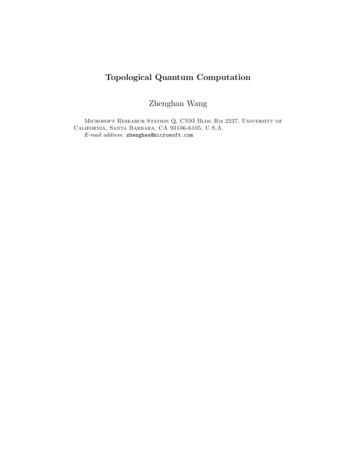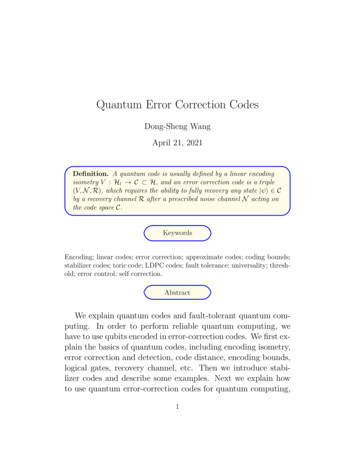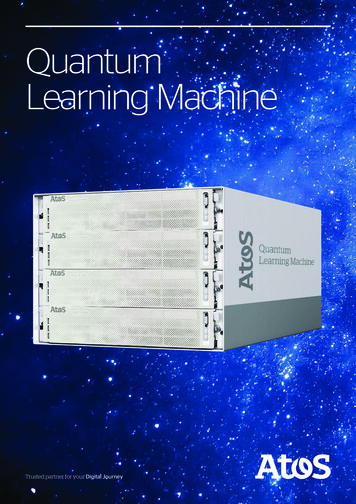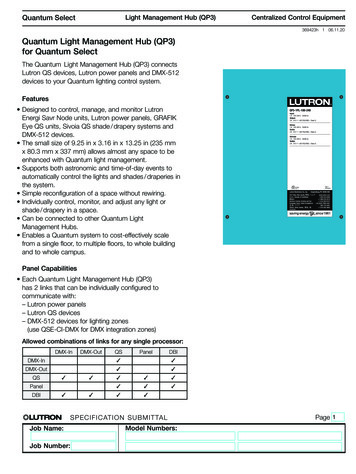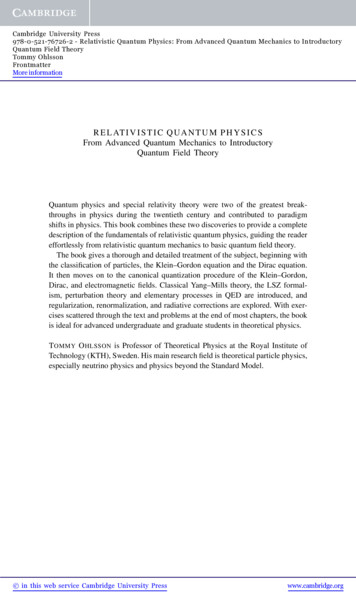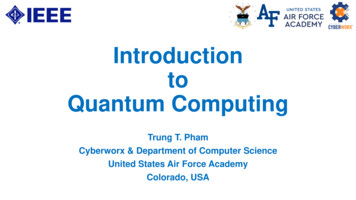
Transcription
Introduction toTopological Quantum ComputingSteven H. SimonBut First: A longwinded introduction on the history of this fieldReference:Non-Abelian Anyons and Topological Quantum ComputationS. DasSarma , M. Freedman , C. Nayak , S.H. Simon , A. SternarXiv:0707.1889, Rev Mod Phys upcomingThe original string theorist ( 1867)? Lord Kelvin1
Knot Invariant:Picture of a KnotSuch that topologicallyequivalent pictures give thesame outputRulesSome Mathematical QuantityTheory of Knots? Jones Polynomial (V. Jones, 1985)1 t t3 - t42
What about this knot?(Most) Knot InvariantsAre “Exponentially Hard”to Calculate(Jaeger et al 1990)Seemingly Unrelated: Topological Quantum Field Theory TQFT QFT where amplitudes depend only on the topology of the process.(Witten, Moore, Seiberg, Froelich, 1980s) For Chern-Simons TQFT, amplitude of a process is given by the JonesPolynomial of the knot. Integrating out Chern-Simons field leaves “topologicalinteraction”. (Witten, 1989).time 3
Proposed TQFT Computer If you had a TQFT in your lab, by measuring amplitudes, you couldfigure out the Jones Polynomial (M. Freedman, 1990s)Solves a “hard” problem in polynomial timeFlashback to Prehistory ofQuantum ComputingSimulating a quantum system (say the Hubbard model)on a classical computer is exponentially hard.But if you had the physical quantum system in your lab,it could simulate itself easily.Yuri Manin (1980)1. What else could you do besides simulate yourself ?2. What would errors do ?4
Proposed TQFT Computer If you had a TQFT in your lab, by measuring amplitudes, you couldfigure out the Jones Polynomial (M. Freedman, 1990s)1. What else could you do besides simulate yourself ?2. What would errors do ?3. Can we build a TQFT ?Proposed TQFT ComputerThe Sweetest Route To Quantum ComputingWhat we now believe:1. You can do universal quantum computation with certain TQFTs2. Errors are suppressed in a very nice way3. Such systems exist (FQHE; more might exist if we look for them)1. What else could you do besides simulate yourself ?2. What would errors do ?3. Can we build a TQFT ?Station QA. KitaevM. Freedman5
Physics TodayFrom:Bonesteel, HormoziSimon, Zikos, PRL056
Outline: Long-winded introduction Dummy’s Guide to Topological QuantumComputingntumTopological QuagtinpuomCCompute withFQHE!Steve SimonDummy’s Guide To Topological Quantum Computing Uses 2 Dimensional Systems which are realizations of TQFTs,i.e., have quasiparticles with NonAbelian Statistics. Quantum Information is encoded in nonlocal topologicaldegrees of freedom that do not couple to any local quantity. States can be manipulated by dragging (braiding) quasiparticlesaround each other. The operations (gates) performed on the qubits dependsonly on the topology of the braids.7
Statistics in Brief:Statistics:What happens to a many-particle wavefunctionunder “exchange” of identical particles.Dogma:Exchanging twice should be identityØ (r1 , r2 ) Ø (r2 , r1 ) Ferm ion Ø ( r1 , r2 ) !Ø ( r2 , r1 ) BosonsstimeIn 2 1 Dimensions: Two Exchanges IdentityIn 3 1 Dimensions: Two Exchanges IdentityNo Knots in World Lines in 3 1 D !8
Statistics:In 3 1 D : No Knots in World LinesTopologically Different Paths Different PermutationsStatistics are Rep of the Permutation GroupBosons or FermionsIn 2 1 D : Knots in World LinesTopologically Different Paths Different BraidsStatistics are a Rep of the Braid GroupMore Possibilities (Anyons Non-Abelions)What is NonAbelian Statistics ?timeSuppose 2 DegenerateOrthogonal States!1,!2Vector Represents Stater1 r2 r3& a 1 #&a # !! U 1 !!% a2 "% a2 "&a #Ø i a1 ' 1 a2 ' 2 1 !!% a2 "& a 1 # Ø f a1 ' 1 a2 ' 2 !!% a2 "Unitary Matrix Represents(Topological) Braid OperationMatrix RepresentationOf The Braid GroupFroelich, Moore, Read, Witten, 9
Braid Group is "Non-Abelian” Non-Commutative Statistics Are Matrix Representation of Braid Group: Matrices are Non-AbelianNonAbelian StatisticsNon-Abelian Statistics (Summary) : Vector Represents State Within a Degenerate Space!1,!2&a #Ø i a1 ' 1 a2 ' 2 1 !!% a2 " Dimension of degenerate space increases exponentially with number ofquasiparticles. Unitary (Berry’s) Matrix Represents an Adiabatic Braiding OperationØf U ØiUnitary Matrix Depends Only on The Topology of the Braid TQFT10
Dummy’s Guide To Topological Quantum Computing Uses 2 Dimensional Systems With “Non-Abelian” Statistics.(Also known as TQFTs). Quantum Information is encoded in nonlocal topologicalIs this forYes!degrees of freedomthat do not couple to any local quantity.real?FQHE States are (usually) manipulated by dragging (braiding)quasiparticles around each other.Andmaybeperformedsomeday in cold The operations(gates)on the qubits dependstrappedatoms,systems,only on the topology of thespinbraidschiral p-wave superconductors,rotating BECs, JJ arrays, etc FQHE Experiments:BVHIVLHorst Stormer Dan TsuiBob Laughlin11
Xia, Pan, Tsui, Stormer,Pfeiffer,and West, PRL200420.50Mobility31 million cm2/ V-secT 9 mKT 9 mKRxy (h/e )0.4527/30.40Numerical work by Rezayi, Haldane,Morf, and othersstrongly suggests that 8/320.353Rxx (k! )Nonabelian StatisticsReally Exist InQuantum Hall States5/25/27/38/314/512 3/812/5(We Think)Many experiments underway to try to prove this!4.64.85.05.25.45.65.806.0B (T)Dummy’s Guide To Topological Quantum Computing Uses 2 Dimensional Systems With “Non-Abelian” Statistics.(Also known as TQFTs). Quantum Information is encoded in nonlocal topologicalIs this forYes!degrees of freedomthat do not couple to any local quantity.FQHEreal? States are (usually) manipulated by dragging (braiding)quasiparticles around each other.Andmaybeperformedsomeday in spin The operations(gates)on the qubits dependssystems,coldtrappedatoms,only on the topology of the braidschiral p-wave superconductors,rotating BECs, JJ arrays, etc 12
Dummy’s Guide To Topological Quantum Computing Uses 2 Dimensional Systems With “Non-Abelian” Statistics.If you could design any Hamiltonian, you could choose(Also known asoneTQFTs).that gives Nonabelian Statistics.None of these Hamiltonians are particularly simple. Quantum Informationis (yet!)encodednonlocaltopologicalNone havebeeninfoundin nature.Yes!degrees of freedomthat do not couple to any local quantity. Kitaev, Freedman, Levin, Wen, Nayak, Shtengel, Fendley,FQHEFradkin, States are (usually) manipulated by dragging (braiding)quasiparticles around each other.Andmaybeperformedsomeday in spin The operations(gates)on the qubits dependssystems,coldtrappedatoms,only on the topology of thebraidschiral p-wave superconductors,rotating BECs, JJ arrays, etc Dummy’s Guide To Topological Quantum Computing Uses 2 Dimensional Systems With “Non-Abelian” Statistics.If you could design any Hamiltonian, you could choose(Also known asoneTQFTs).that gives Nonabelian Statistics.In cold atom lattices you can design your Hamiltonian Quantum Informationin nonlocal topologicalbut is .encoded(T, t)Yes!degrees of freedomthat do not couple to any local quantity. Zoller et al; Troyer, Whaley,FQHE States are (usually) manipulated by dragging (braiding)quasiparticles around each other.Andmaybeperformedsomeday in spin The operations(gates)on the qubits dependssystems,coldtrappedatoms,only on the topology of the braidschiral p-wave superconductors,rotating BECs, JJ arrays, etc 13
Dummy’s Guide To Topological Quantum Computing Uses 2 Dimensional Systems With “Non-Abelian” Statistics.(Also known as1)TQFTs).Real Superconductors: SrRuO4 ? Quantum Informationencodedin nonlocaltopological(2) Chiralisp-wavepairingof cold atoms?Yes!Radzihovsky,Gurarie,et al but (T,t)degrees of freedomthat do notcoupleto anylocalquantity.FQHE States are (usually) manipulated by dragging (braiding)quasiparticles around each other.Andmaybeperformedsomeday in spin The operations(gates)on the qubits dependssystems,coldtrappedatoms,only on the topology of thebraidschiral p-wave superconductors,rotating BECs, JJ arrays, etc Dummy’s Guide To Topological Quantum Computing Uses 2 DimensionalSystems With “Non-Abelian” Statistics.Rotating BEC Quantum Hall Effect in Disguise(Also known as TQFTs).Coriolis Force Lorentz Force Quantum InformationencodedRatein nonlocalRatio of is(Rotation/ Density)topologicalneeds to beYes!Increasedof magnitudestill. .quantity.and (T, t)degrees of freedomthat1-2do ordersnot coupleto any localFQHECooper, Gunn, Wilken, Read, Rezayi, States are (usually) manipulated by dragging (braiding)quasiparticles around each other.Andmaybeperformedsomeday in spin The operations(gates)on the qubits dependssystems,coldtrappedatoms,only on the topology of the braidschiral p-wave superconductors,rotating BECs, JJ arrays, etc 14
Dummy’s Guide To Topological Quantum Computing Uses 2 Dimensional Systems With “Non-Abelian” Statistics.Arrays .(Also known asJJTQFTs).Still a long way to go Quantum Information is encoded in nonlocal topological ask Lev Yes!degrees of freedomthat do not couple to any local quantity.FQHE States are (usually) manipulated by dragging (braiding)quasiparticles around each other.Andmaybeperformedsomeday in spin The operations(gates)on the qubits dependssystems,coldtrappedatoms,only on the topology of thebraidschiral p-wave superconductors,rotating BECs, JJ arrays, etc Dummy’s Guide To Topological Quantum Computing Uses 2 Dimensional Systems With “Non-Abelian” Statistics.(Also known as TQFTs). Quantum Information is encoded in nonlocal topologicalYes!degrees of freedomthat do not couple to any local Signsquantity.FQHEpoint toYES States are (usually) manipulated by dragging (braiding)quasiparticles around each other.In FQHE we believe we have alreadycreated phases of matter where The operations (gates) nonabelianperformed onstatisticsthe qubitsexists.dependsonly on the topology of the braids15
Re:Theoretical EvidenceObservation of FQHEH Interacting2D Electrons in BNumericsTrial Wavefunctionsintegrate outhigh energyConformal Field TheoryLow Energy(Chern-Simons)TQFTRe:Theoretical CommentSymmetry Emergence – not symmetry breaking!H Interacting2D Electrons in BLower Symmetryintegrate outhigh energyLow Energy(Chern-Simons)TQFTHigher emergent symmetry16
Dummy’s Guide To Topological Quantum Computing Uses 2 Dimensional Systems which are realizations of TQFTs,i.e., have quasiparticles with NonAbelian Statistics. Quantum Information is encoded in nonlocal topologicaldegrees of freedom that do not couple to any local quantity. States can be manipulated by dragging (braiding) quasiparticlesaround each other. The operations (gates) performed on the qubits dependsonly on the topology of the braids.Quasiparticles in Fractional QHE Quasiparticles are topological defects Charge lives in the core topological degrees of freedom live in the “vorticity” (sort of)The topological degree of freedom can be thought of as theconfiguration class of the emergent Chern-Simons gauge field.Energy is independent of this topological degree of freedom.17
Topological Quantum Numbers: (Usually) An individual quasiparticle exists only in a single stateTopological Quantum Numbers:0 or 1 (qubit)Two (or more) quasiparticles can exist in more than one state described by a quantum number, ex 0 or 1You cannot determine the quantum number byonly measuring one of the quasiparticles18
Topological Quantum Numbers:0,1,. Groups of particles similarly have quantum numbersThese quantum numbers can be thought of as describing theglobal topology of the effective Chern-Simons gauge fieldDummy’s Guide To Topological Quantum Computing Uses 2 Dimensional Systems which are realizations of TQFTs,i.e., have quasiparticles with NonAbelian Statistics. Quantum Information is encoded in nonlocal topologicaldegrees of freedom that do not couple to any local quantity. States can be manipulated by dragging (braiding) quasiparticlesaround each other. The operations (gates) performed on the qubits dependsonly on the topology of the braids.19
Topological Quantum Numbers:0,1,. Groups of particles similarly have quantum numbersThese quantum numbers can be thought of as describing theglobal topology of the effective Chern-Simons gauge fieldNo local measurements can determine this quantum number! No local operator can couple to this quantum number Topological quantum numbers decoupled from “noise”Comparison with Conventional Error Protection:Conventional Protection:Topological Protection:Many Physical Qubits Code One“Logical” or Computational QubitGlobal topology codes qubitsα 00000 β 11111 PhysicalDetailed Geometryredundancyredundancyα 0 β 1 LogicalSoftware Error CorrectionTopologyHardware Error ProtectionMidway: Bacon Codes etc20
Dummy’s Guide To Topological Quantum Computing Uses 2 Dimensional Systems which are realizations of TQFTs,i.e., have quasiparticles with NonAbelian Statistics. Quantum Information is encoded in nonlocal topologicaldegrees of freedom that do not couple to any local quantity. States are (usually) manipulated by dragging (braiding)quasiparticles around each other. How to Measure ?Manipulate?The operationsHow(gates) toperformedon the qubits dependsonly on the topology of the braidsTopological Quantum Numbers: To Measure the Quantum Number(1) Move the particles microscopically close, and measure force21
Topological Quantum Numbers:testparticle To Measure the Quantum Number(1) Move the particles microscopically close, and measure forceOR(2) Do an interference experiment surrounding both quasiparticlesDummy’s Guide To Topological Quantum Computing Uses 2 Dimensional Systems which are realizations of TQFTs,i.e., have quasiparticles with NonAbelian Statistics. Quantum Information is encoded in nonlocal topologicaldegrees of freedom that do not couple to any local quantity. States can be manipulated by dragging (braiding) quasiparticlesaround each other. The operations (gates) performed on the qubits dependsonly on the topology of the braids.22
Dragging (Braiding) Particles Adiabatically--------Dragging (Braiding) Particles Adiabatically--------23
timeDragging (Braiding) Particles Adiabatically--------Major Simplification!Theorem (Simon, Bonesteel, Freedman PRL05): In any topologicalquantum computer, all computations can be performed by movingonly a single quasiparticle!Reduced technological difficulty!24
Simple Example: 5/2 state00Ψi 00〉Simple Example: 5/2 state--25
Simple Example: 5/2 state--11Ψf 11〉Not quite so simple example: 12/5 state00Ψi 00〉26
Not quite so simple example: 12/5 state--Not quite so simple example: 12/5 stateTHIS IS A VERY SIMPLE QUANTUM COMPUTATION--0 or 1Ψf A 00〉 B 11〉0 or 1 B/A golden mean (1 5 )227
Dummy’s Guide To Topological Quantum Computing Uses 2 Dimensional Systems which are realizations of TQFTs,i.e., have quasiparticles with NonAbelian Statistics. Quantum Information is encoded in nonlocal topologicaldegrees of freedom that do not couple to any local quantity. States can be manipulated by dragging (braiding) quasiparticlesaround each other. The operations (gates) performed on the qubits dependsonly on the topology of the braids.Topological Robustness28
Topological Robustnesstime Dummy’s Guide To Topological Quantum Computing Uses 2 Dimensional Systems With “Non-Abelian” Statistics.(Also known as TQFTs).Quantum Information is TopologicallyProtected (Isolated) From Decoherence Quantum Information is encoded in nonlocal topologicaldegrees of freedom that do notcouple to any local quantity.ANDThebeOperationsareProtected! States canmanipulatedbyTopologicallydragging (braiding)quasiparticlesaround each other. The operations (gates) performed on the qubits dependsonly on the topology of the braids29
Quantum CircuitUUQuantum CircuitUU30
BraidFrom an interview with Bill Gates in the May,2004 online edition of Scientific American31
Outline: Long-winded introduction Dummy’s Guide to Topological QuantumComputing FAQntumTopological QuagtinpuomCCompute withFQHE!Steve SimonFrequently Asked Questions1.Is there ANY decoherence?2.Why is topological so much better than nontopological q-computing?3.Does it matter if you put the quasiparticles back where they started?4.Can you quantum compute with the 5/2 state?5.What other fractions are interesting?6.How far apart should the particle be,and how fast should you move the particles around.7.Can you show me a CNOT gate? how accurate is it?8.How many braid operations does it take to do a useful computation9.Do you really believe this?32
Frequently Asked Questions1.Is there ANY decoherence?2.Why is topological so much better than nontopological q-computing?3.Does it matter if you put the quasiparticles back where they started?4.Can you quantum compute with the 5/2 state?5.What other fractions are interesting?6.How far apart should the particle be,and how fast should you move the particles around.7.Can you show me a CNOT gate? how accurate is it?8.How many braid operations does it take to do a useful computation9.Do you really believe this?timeDecoherence?Topologically Nontrivial Processes Creates DecoherenceThese process can be eliminated exponentially at low T!33
Frequently Asked Questions1.Is there ANY decoherence?2.Why is topological so much better than nontopological q-computing?3.Does it matter if you put the quasiparticles back where they started?4.Can you quantum compute with the 5/2 state?5.What other fractions are interesting?6.How far apart should the particle be,and how fast should you move the particles around.7.Can you show me a CNOT gate? how accurate is it?8.How many braid operations does it take to do a useful computation9.Do you really believe this?Why is topological so good Topological Protection of Memory ‒‒ Decoherence is suppressed EXPONENTIALLY Operations are AUTOMATICALLY PRECISE (quantized) "Beauty is truth, truth beauty,--that is allye know on earth, and all ye need to know." - Keats34
Frequently Asked Questions1.Is there ANY decoherence?2.Why is topological so much better than nontopological q-computing?3.Does it matter if you put the quasiparticles back where they started?4.Can you quantum compute with the 5/2 state?5.What other fractions are interesting?6.How far apart should the particle be,and how fast should you move the particles around.7.Can you show me a CNOT gate? how accurate is it?8.How many braid operations does it take to do a useful computation9.Do you really believe this?Not quite so simple example: 12/5 state00Ψi 00〉35
Not quite so simple example: 12/5 state--Not quite so simple example: 12/5 stateTHIS IS A VERY SIMPLE QUANTUM COMPUTATION--0 or 1Ψf A 00〉 B 11〉0 or 1 B/A golden mean (1 5 )236
Frequently Asked Questions1.Is there ANY decoherence?2.Why is topological so much better than nontopological q-computing?3.Does it matter if you put the quasiparticles back where they started?4.Can you quantum compute with the 5/2 state?5.What other fractions are interesting?6.How far apart should the particle be,and how fast should you move the particles around.7.Can you show me a CNOT gate? how accurate is it?8.How many braid operations does it take to do a useful computation9.Do you really believe this?Does 5/2 compute?Universal Q-Computation Approximate any Unitary TransformThe Moore-Read Pfaffian Cannot Do This!Braid Group Representation is not “Dense”BUT . Hybrid schemes might work!37
Frequently Asked Questions1.Is there ANY decoherence?2.Why is topological so much better than nontopological q-computing?3.Does it matter if you put the quasiparticles back where they started?4.Can you quantum compute with the 5/2 state?5.What other fractions are interesting?6.How far apart should the particle be,and how fast should you move the particles around.7.Can you show me a CNOT gate? how accurate is it?8.How many braid operations does it take to do a useful computation9.Do you really believe this?Universal Set of Topologically Robust Gates(Bonesteel, Hormozi, Simon, 2005, 2006)Single qubit rotations:!U !rU !r !Controlled NOT:38
Solovay-Kitaev Improved CNOTFrequently Asked Questions1.Is there ANY decoherence?2.Why is topological so much better than nontopological q-computing?3.Does it matter if you put the quasiparticles back where they started?4.Can you quantum compute with the 5/2 state?5.What other fractions are interesting?6.How far apart should the particle be,and how fast should you move the particles around.7.Can you show me a CNOT gate? how accurate is it?8.How many braid operations does it take to do a useful computation9.Do you really believe this?39
Frequently Asked QuestionsDo you really believe this?Introduction toTopological Quantum Computing40
Introduction toTopological Quantum Computing41
These quantum numbers can be thought of as describing the global topology of the effective Chern-Simons gauge field Dummy's Guide To Topological Quantum Computing Uses 2 Dimensional Systems which are realizations of TQFTs, i.e., have quasiparticles with NonAbelian Statistics. Quantum Information is encoded in nonlocal topological
